Articles
- Page Path
- HOME > J Korean Acad Nurs > Volume 38(1); 2008 > Article
-
Original Article
- Development and Evaluation of an e-Learning Program for Mothers of Premature Infants
- Nae-Young Lee, Young-Hae Kim
-
Journal of Korean Academy of Nursing 2008;38(1):152-160.
DOI: https://doi.org/10.4040/jkan.2008.38.1.152
Published online: February 28, 2008
1Instructor, College of Nursing, Pusan National University, Busan, Korea.
2Professor, College of Nursing, Pusan National University, Busan, Korea.
- Address reprint requests to: Kim, Young-Hae. College of Nursing, Pusan National University, 1-10 Ami-dong, Seo-gu, Busan 602-739, Korea. Tel: 82-51-240-7752, Fax: 82-51-248-2689, ungaekim@pusan.ac.kr
• Received: September 18, 2007 • Accepted: December 19, 2007
Copyright © 2008 Korean Society of Nursing Science
Abstract
-
Purpose
- It has been attempted to support mother of premature infants by providing information of premature infant care using e-learning because premature infants need continuous care from birth to after discharge.
-
Methods
- The e-Learning Program for mother of premature was developed with Xpert, Namo web editor, Adobe Photoshop, and PowerPoint and applied for 4 weeks from 4 to 30 September 2006.
-
Results
- 1) We found that the contents of information which premature infants' need when being in the hospital and after discharge were the definition of a premature infant, orientation of NICU, care of premature infants, care of premature infants' common diseases, the connection of healthcare resources, exchange of information, and the management of rearing stress. 2) The program content consisted of cause of premature birth, comparison to full-term baby, physiology character, orientation of NICU, common health problems, follow up care, infection control, feeding, normal development physically and mentally, weaning method, and vaccination.
-
Conclusion
- Considering the results, this program for mother of premature is a useful means to provide premature-care information to mothers. This information can be readily accessible and can be varied and complex enough to be able to help mothers to the information and assistance they require.
- 1. Ahn YM, Kim JH. Comparison of maternal selfesteem, postpartal depression, and family function in mothers of normal and of low birth-weight infants. J Korean Acad Nurs. 2003;33:580–590.ArticlePDF
- 2. Blackburn S. Problems of preterm infant after discharge. JOGNN. 1995;24(1):43–49.PubMed
- 3. Brooten D, Gennaro S, Knapp H, Brown LP, York R. Clinical specialist pre- and postdischarge teaching of parents of very low birth weight infants. J Obstet Gynecol Neonatal Nurs. 1988;18:316–322.Article
- 4. Chae SM. Development and evaluation of transitional care program for low birth weight infants and mothers. 2001;Seoul, Yonsei University. Unpublished doctoral dissertation.
- 5. Choi YB. Effects of information via e-mail on parental attachment behavior of a premature infant. 2005;Seoul, Yonsei University. Unpublished master's thesis.
- 6. Chun BC. E-health and internet in medicine-a strategic perspective. J Korean Med Assoc. 2002;45(1):4–16.Article
- 7. Drake E. Discharge teaching needs of parents in the NICU. Neonatal Netw. 1995;14(1):49–53.
- 8. Gupton A, Heaman M. Learning needs of hospitalized Women at risk for preterm birth. Appl Nurs Res. 1994;7:118–124.ArticlePubMed
- 9. Han KJ. Development of a home-based nursing intervention mothering program for low-birth-weight infants. J Korean Acad Home Healthc Nurse. 2001;8(1):5–24.
- 10. Jang YS. Development of model for a prematures' health promotion center which is integrated with school, hospital and primary health center. 2004;Kwangju, Junnam National University. Unpublished doctoral dissertation.
- 11. Jo WJ, Lee CJ. Study of developing a internet support program for cooperating teachers. J Korean Teacher Education. 2002;19(2):57–79.
- 12. Jotzo M, Poets CF. Helping parents cope with the trauma of premature birth: an evaluation of a trauma-preventive psychological intervention. Pediatrics. 2005;115:915–919.ArticlePubMedPDF
- 13. Jun KJ, Yoon SJ, Go KS. Assessment of the public health program of health center for premature and congenital anomaly infants. J Korean Soc Matern Child Health. 2002;5:199–214.
- 14. Jung HK. Hemodialysis nursing education program using Web-based learning system. Nurs Query. 2000;9(1):146–166.
- 15. Keller J, Burkman E. Fleming M, Levie WH. Motivation principles. In: Instructional message design. 1993;Englewood Cliffs, New Jersey, Educational Technology Publications.
- 16. Kim JS. Development and evaluation of the web-based program for maternal role support of the primiparas. 2005;Seoul, Seoul National University. Unpublished doctoral dissertation.
- 17. Kim JY. Effect of massage program on premature infants' growth and on the mothering role confidence and satisfaction. 2004;Kwangju, Junnam National University. Unpublished doctoral dissertation.
- 18. Kim SO. Survey for health care needs of premature baby at home. 2001;Seoul, Yonsei University. Unpublished master's thesis.
- 19. Klein M, Stem L. Low birth weight and the battered child syndrome. Am J Dis Child. 1971;122(1):15–18.ArticlePubMed
- 20. Korean National Statistical Office. Birth and death data for 2005. 2006.
- 21. Ku BN, Kim MY. Maternal role confidence. Kungbuk J Nurs Sci. 2002;6(1):39–56.
- 22. Kwon HK. Affect of discharge education program for mothers of premature infants on maternal role confidence and parenting stress. 2006;Kangnung, Kwandong University. Unpublished master's thesis.
- 23. Lee DH. Problem and solution by low delivery. In: Subject of the 18th Fall conference in the Korean Society of Maternal and Child Health. 2005;83–89.
- 24. Lee IH. Development of model for a prematures' health promotion center which is integrated with school, hospital and primary health center. Technology. 2004;33:105–116.
- 25. Lee SH, Ji SA. A study on experience of the mother of premature infant in NICU. Chung-Ang J Nurs. 2001;5(2):45–53.
- 26. McKim ED. The difficult first week at home with a premature infant. Public Health Nurs. 1993;10(2):89–96.ArticlePubMed
- 27. Melnyk BM, Alpert-Gillis L, Feinstein NF, Fairbanks E, Schultz-Czarniak J, Hust D, et al. Improving cognitive development of low-birth-weight premature infants with the COPE program: a pilot study of the benefit of early NICU intervention with mothers. Res Nurs Health. 2001;24:373–389.ArticlePubMed
- 28. Moore M, Kearsley G. Distance Education-A systems view. 1996;Boston, Wadsworth Publishing Company.
- 29. Na IJ. Web-based edcation. 2005;Seoul, Kwahakkyoksa Publising.
- 30. Park JH, Lee SW. Infants' health problem by birth rate decrease. In: Paper presented at the 17th Spring conference of the Korean Society of Maternal and Child Health. 2005.
- 31. Park SJ, Lee MJ, Hong YH, Kim SY, Yoo EJ. The development of educational multimedia for mothers of premature infants. Annual Bulletin of The Bum-Suk Academic Scholarship Foundation. 2003;7:127–135.
- 32. Park WS. Premature infants follow-up program. J Korean Pediatr Assoc. 2003;46:319–325.
- 33. Shin YH. Current status of korean premature infant care and its prospective. Korean J Child Health Nurs. 2003;9(1):96–106.
- 34. Song AS. Effect of supportive care for mothers of premature infants on anxiety and confidence of baby care after discharge. 2005;Kwangju, Junnam National University. Unpublished master's thesis.
- 35. Song HS, Shin HS. Effects of a sensory stimulation on weight gain, behavioral state, and physiological responses in premature infants. J Nurs Acad Soc. 2001;31:703–711.ArticlePDF
- 36. Westrup B, Kleberg A, von Eichwald K, Stjernqvist K, Lagercrantz HA. A randomized, controlled trial to evaluate the effects of the newborn individualized developmental care and assessment program in a Swedish setting. Pediatrics. 2000;105:66–72.ArticlePubMedPDF
REFERENCES
Figure & Data
REFERENCES
Citations
Citations to this article as recorded by 

- The effect of an emotional support training program on acute stress disorder among mothers of preterm infants hospitalized in neonatal intensive care units
Dua'a F. Al-Maghaireh, Inaam A. Khalaf, Khatijah Lim Abdullah, Chong Mei Chan, Niven R. Basyoun, Mariam M. Kawafha
Journal of Neonatal Nursing.2020; 26(5): 273. CrossRef - A Smart Phone Application for the Mothers of Premature Infants
A. Nourani, H. Ayatollahi, K. Mirnia
IRBM.2019; 40(5): 263. CrossRef - Development of Pre-discharge Group Education Program for Liver Transplant Patients
Ji Seon Yun, Kyung Choon Lim, Jae Sim Jeong, Hea Seon Ha, Jung Ja Hong, Soon Haeng Lee, Lee Young Kim, Yeon Hee Kim, Shin Hwang
Korean Journal of Transplantation.2017; 31(1): 34. CrossRef - Integrative Review on Caring Education Papers for Parents with a Premature Infant.
Mihae Im, Jina Oh
Child Health Nursing Research.2013; 19(2): 120. CrossRef - Development and Evaluation of a Video Discharge Education Program focusing on Mother-infant Interaction for Mothers of Premature Infants
Jin Suk Ra, Jiyoung Lim
Journal of Korean Academy of Nursing.2012; 42(7): 936. CrossRef - Construction a Website for Premature Infant - Based on the Survey of Previous Homepages -
In Hae Lee
Journal of Korean Academy of Child Health Nursing.2009; 15(2): 210. CrossRef
- Figure
- We recommend
- Related articles
-
- Development and Evaluation of Evidence-Based Nursing Protocol for Extracorporeal Membrane Oxygenation to Critically Ill Patients
- Development and Validation of a Dignity in Care Scale of Terminally Ill Patients for Nurses
- The Effects of the Infant Health Promotion Program for Mothers with Their Firstborn Infants
- Development and Evaluation of an App-Based Self-Management Program for Exercise Practice of Breast Cancer Survivors: A Non-Randomized Controlled Trial
- Development and Effectiveness Evaluation of Comprehensive Mobile-Based, Breastfeeding Promotion Program for Mothers with Gestational Diabetes
Development and Evaluation of an e-Learning Program for Mothers of Premature Infants
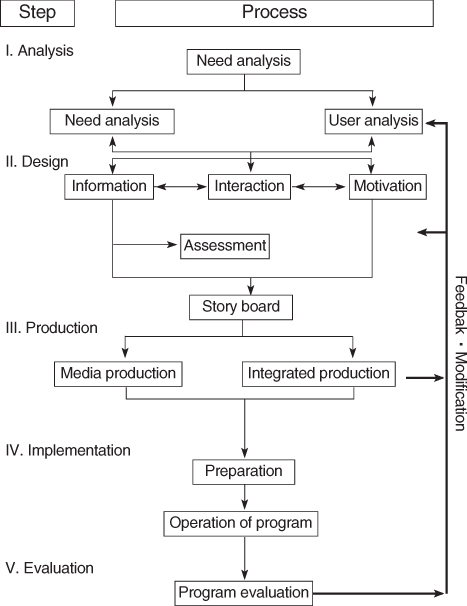
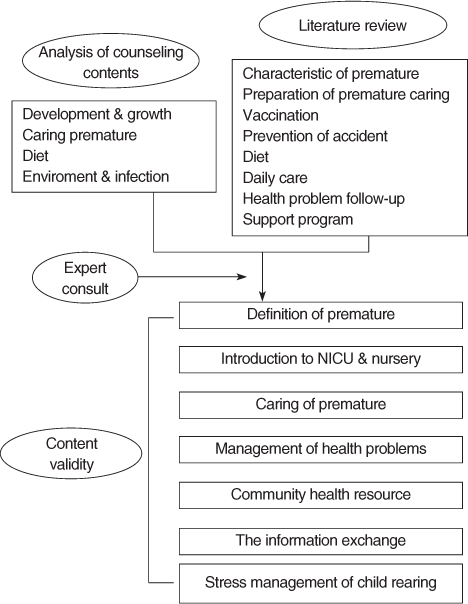
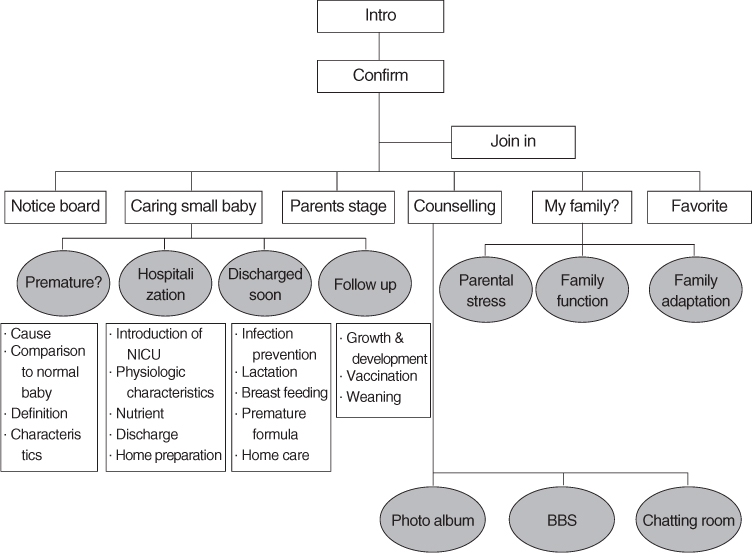
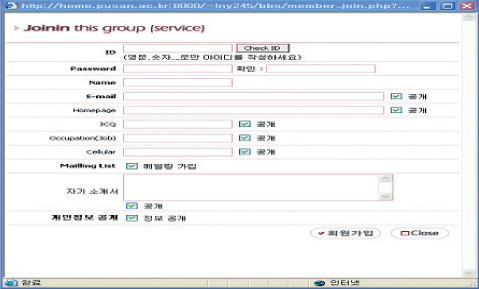
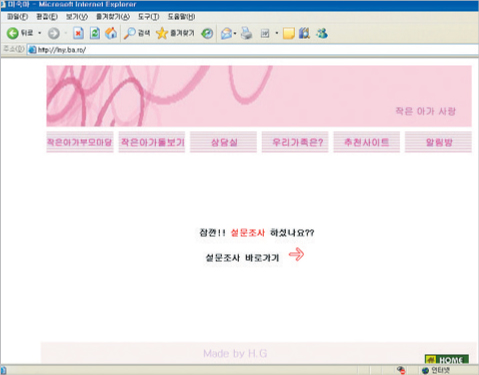
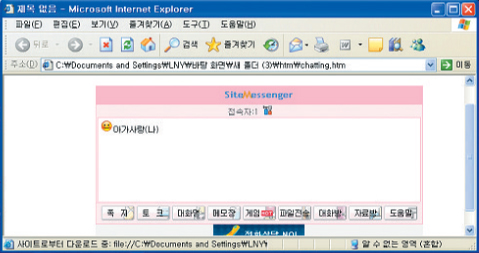
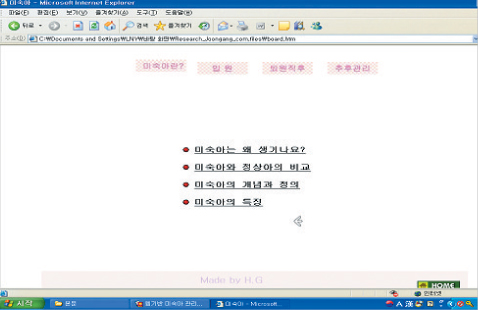
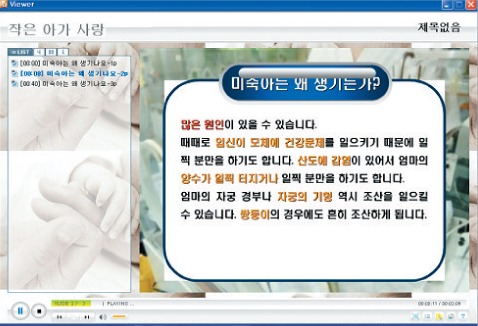
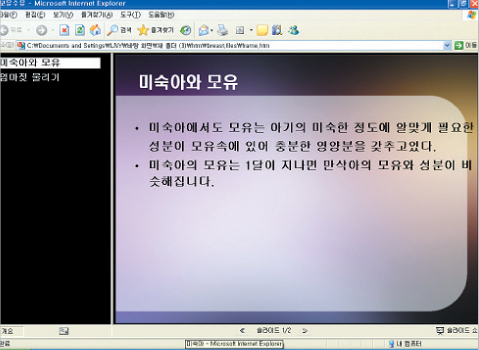
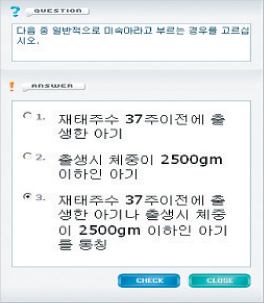
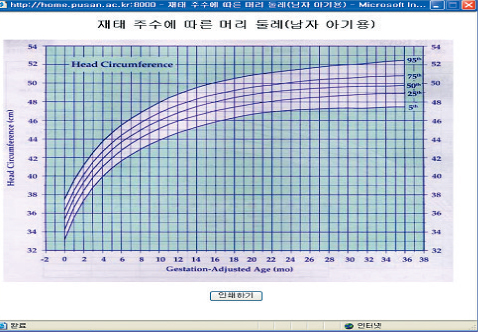
Figure 1
The model for procedure in web based premature infant care program.
Figure 2
Analysis of contents.
Figure 3
Structure of the program.
Figure 4
Page of create an account.
Figure 5
Main page.
Figure 6
Chatting room.
Figure 7
Caring of small baby.
Figure 8
Subcontents page.
Figure 9
Subcontents page.
Figure 10
Self-examination.
Figure 11
Print page of growth charts.
Figure 1
Figure 2
Figure 3
Figure 4
Figure 5
Figure 6
Figure 7
Figure 8
Figure 9
Figure 10
Figure 11
Development and Evaluation of an e-Learning Program for Mothers of Premature Infants
Content Validity of the Program
Program Evaluation
Table 1
Content Validity of the Program
Table 2
Program Evaluation
 KSNS
KSNS
 E-SUBMISSION
E-SUBMISSION











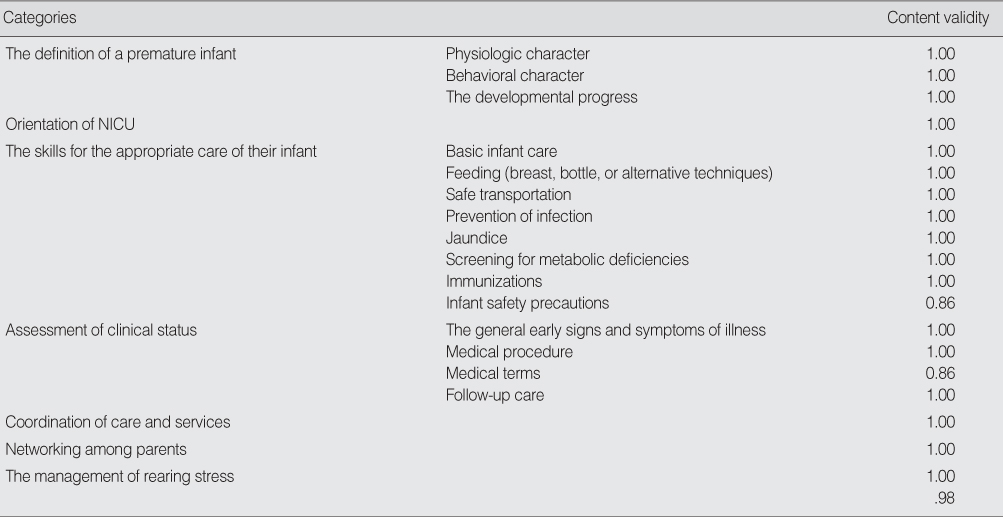
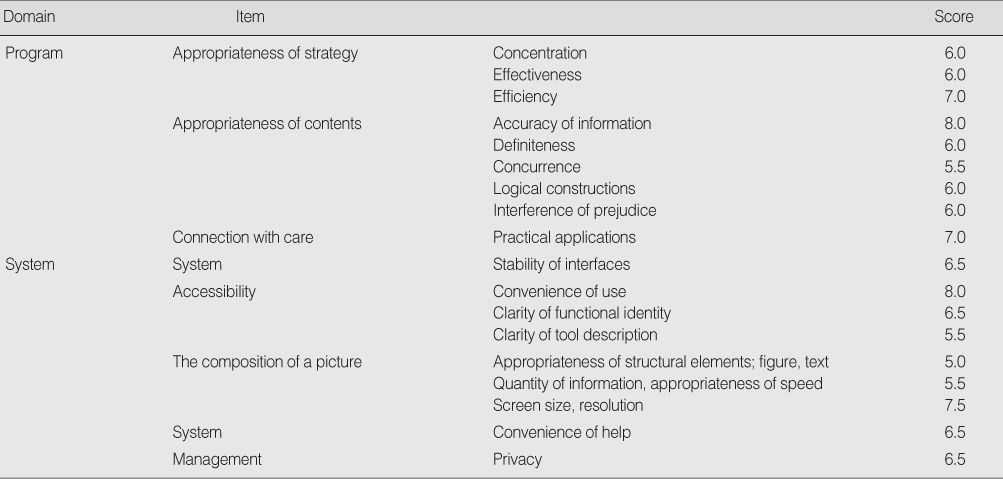
 Cite
Cite

